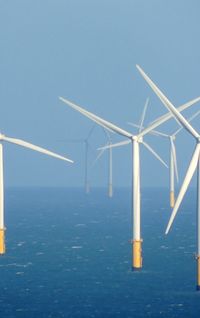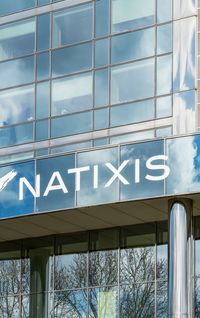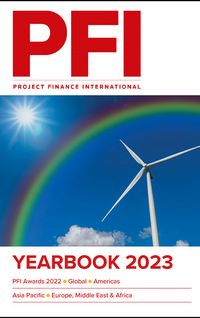Canadian company Innergex went to Latin America to expand its footprint and used the project finance market to optimise the financial structure of its renewables portfolio. Similar deals are set to follow across the region. By Nic Stone.
Quebec-based Innergex Renewable Energy was founded in 1990 to bid into the Canadian province’s call for private-sector operators to develop small hydro projects. By 1994, the company’s first project was online in its home province, adding a few megawatts to the grid. But the hydro-focused independent power producer soon found that there weren’t enough rivers in Quebec to sate its appetite and so it started to look further afield.
First, the company got a project in neighbouring Ontario, then it went to British Columbia. When hydro wasn’t enough, Innergex turned its attention to other renewables and brought online its first wind farm in home province Quebec in 2006. But other countries beckoned.
“Really it started in 2015, we started to look outside of Canada more,” Innergex chief executive officer Michel Letellier tells PFI. “We went to France looking for opportunities. Then we went to the US and towards Mexico, and then finally checked out Peru and Chile.”
It was in Chile that this process of expansion found itself in June 2022, with the close of Innergex’s massive purchase of Aela Energia from Actis (60%) and Mainstream Renewable Power (40%) for US$686m with the assumption of US$386m in project finance debt.
In order to optimise the financials, Innergex set about structuring a project finance-style deal. But the group already had some other smaller assets in the country that were subject to various old loans and hedge agreements, which weren’t bringing the economic benefits that the company wanted.
In late 2021, when Innergex was firming up the deal to buy Aela, Letellier says, the company tapped SMBC as financial adviser to guide it through the purchase.
The acquisition closed in June and SMBC and another bank CIBC were able to provide bridge financing in order to get the deal done and set it up for the ultimate plan, the refinancing of the entire deal and optimisation of the structure of the company’s entire portfolio in Chile.
“The strategy behind the financing really was that we thought having one portfolio and one lender would be easier,” Letellier says, adding that streamlining all the assets and their various financial structures into one portfolio and one source of capital, the bond market, felt like the best structure.
Indeed, the portfolio was a rather higgledy-piggledy collection of technologies and loan deals. The portfolio being refinanced includes the assets purchased from Aela Energia and comprises a combination of solar, wind, and hydro assets as well as battery energy storage system (BESS) assets wholly owned by Innergex.
Included in the portfolio are the San Andres solar farm (50.6MW) and three Aela wind farms (332MW), both acquired earlier this year, as well as the Lican hydro facility (18MW), Mampil hydro facility (55MW), Peuchen hydro facility (85MW), and Salvador solar facility (68MW), together with a 50MW/250MWh BESS project currently under construction.
On August 5, Innergex completed its planned US$803.1m refinancing of the purchase and non-recourse debt on its portfolio, while financing the company’s maiden battery storage project in the country.
The deal included US$710m in green bonds maturing in 2036 priced at 6.28%, ICUR plus 330bp, with a balloon payment of US$139m, and a US$93.1m letter of credit facility. The deal unlocked roughly US$31.45m in cash trapped in reserve accounts and benefits from a pre-hedging strategy providing an additional US$55.5m in cash.
SMBC and CIBC acted as placement agent and co-agent respectively for this transaction. SMBC not only acted as financial adviser to Innergex in respect of the structuring of the transaction, but also as sole green bond coordinator and as sole issuing bank of the letter of credit facility. The green bonds were offered in a private placement under Section 4(a)(2).
The money got to a lot of work. Net proceeds of US$176.2m were used to finance the acquisition of the Aela wind farms, while US$72.6m was used to finance all development activities for the Salvador energy storage project. The remaining balance was used to repay US$548.7m of the existing debt and other transaction costs.
The issuance of green bonds is also related to the forward-start interest rate swaps entered into on February 17 2022 with an aggregate notional amount of US$331.2m.
The green bonds were sold to “a core group of global institutional investors” and the issue was significantly oversubscribed, according to Innergex.
“We saw that the hydro assets were financed with two local banks and they had provisions and cash sweeps that were not so exciting,” Letellier says. “So we swapped and fixed the rates. It was an OK financing originally, but it was short, with not a big balloon.”
On July 25, the interest rate swaps previously entered into were settled in favour of Innergex, for US$41.2m. The unwinding of interest rate swaps related to the current financings will provide an additional US$14.6m of cash.
The Chilean portfolio of assets received an investment-grade rating from Standard & Poor’s, and the green bonds were priced on a margin to US Treasuries.
“The idea was basically to engineer the amount we could borrow and the interest coupon based on a BBB rating,” Letellier says. “We worked with S&P on this and basically re-engineered all of our cashflow to meet their criteria.”
The key question Innergex had to answer was how much cashflow the projects could support in terms of borrowings, while maintaining pricing that was attractive. And Letellier says the company was aware of Chile’s recent history when power pricing dropped precipitously and hit some project finance loans backing renewables projects.
Indeed, one of the projects in Innergex’s Chilean portfolio, the 70MW PV Salvador solar farm, was bought from IPP Etrion in May 2020 after that company had struggled with the loans it had taken out backing the scheme. Etrion had been looking to amend terms on the project finance loan it took out backing the project in 2017 before selling.
The non-recourse project loan was obtained at the time through the US Overseas Private Investment Corporation (OPIC) – which went on to become the US Development Finance Corporation (DFC) – and was set to mature in 2033. But Etrion reported a writedown on Salvador due to depressed spot market prices in Chile. The project alone caused an impairment expense of US$75.7m and net deferred tax write-off of US$6.9m.
As for the rest of the assumed PF debt, Aela secured a sizeable US$436.5m deal in 2017 backing the 170MW Sarco and 129MW Aurora wind farms, a 73km transmission line linking Sarco to the existing Maitencillo substation, and the refinancing of the debt backing the then operational 33MW Cuel wind farm. The loan had an 18-year tenor.
The financing was provided by IDB Invest, SMBC, MUFG, Korea Development Bank, Caixabank, and KfW IPEX-Bank. VAT financing was provided by Banco Santander Chile. Clifford Chance advised the borrower, while Milbank advised the lenders.
“It took a little bit of time and interaction, and we only fixed the amount of the loans at the last moment, linked to the interest rate we wanted to have,” Letellier says, while adding that close on the financing immediately allowed the company to close the portion of the deal that saw it free US$31.45m in cash trapped in reserve accounts and benefit from a pre-hedging strategy providing an additional US$55.5m in cash.
“As soon as we signed the deal we went and did the equity issue and then we also hedged 100% of the refi,” Letellier says. “We had to make sure at the end of the day that the synchronicity with the fixing of the rate and loan size worked with that portfolio approach. We knew that the market was volatile in the last year or so, so we didn’t want to get there naked.
“We were able to convince a group of financiers and we got S&P to rate the deal,” says Letellier. “The group of investors understood that strategy. We were able to get decent leverage at a decent price. Not cheap, but decent. Deals in Chile require a little more premium to deals in say the US, so the spread was a little up.”
All told, the moves have so far given a boost to the company’s revenues. “All of our recent acquisitions and growth initiatives combined contributed significantly to our 40% growth in revenues and 48% increase in adjusted Ebitda recorded in the quarter,” Letellier said on the company’s most recent earnings call.
What attracted Innergex to Chile and this particular deal is something that is increasing in prevalence in project finance markets. With power pricing so low, it sometimes behoves companies to buy their way into a market rather than look to secure contracts or try their luck with development.
Letellier says of some of the power pricing, “you can’t build a new facility at that price”. Companies that want exposure and potential benefits from investing in the Latin American renewables space are increasingly looking to buy into portfolios of operating assets.
What’s more, Latin America has seen a wave of left and, depending on your tastes, far-left candidates win elections over the past 12 months.
Most recently, Luiz Inacio Lula da Silva in Brazil returned to power, before him it was Gustavo Petro in Colombia, and of course Chile’s young former student leader turned President Gabriel Boric. All this means strong structural support for renewable proliferation and decarbonisation. Add that to the ample resources and renewables are tipped to thrive.
Shortly after Innergex bought Aela’s portfolio, New York-based Global Infrastructure Partners (GIP) closed the acquisition of Atlas Renewable Energy, also from Actis, in a deal worth almost US$2bn.
Atlas is the second largest independent renewables developer in Latin America, with 14 fully contracted solar assets that produce 2.3GW of power across Brazil, Chile, Mexico, and Uruguay.
The deal follows on from GIP’s 2021 purchase of another Latin America-focused IPP from Actis, Mexican company Saavi Energia. GIP financed that deal with bridge loans and then through Saavi Energia issuing US$350m in 144A/Reg S bonds in part to refinance the bridge facilities, a very similar structure and strategy to that of Innergex.
Indeed, Actis has been on a selling spree of late, following its strategy of looking for buyers for its assets once commercial operation on a sizeable portfolio has been reached.
Petros Lamprinos, a director at Actis in the group’s Mexico City office, tells PFI that for the Innergex deal, once the projects were brought to commercial operation the time came naturally for the process of sale to happen.
“The time to sell is always subject to how the platform evolves and how the market conditions are,” Lamprinos says, adding that the plan was more or less always to sell the assets once the time came. The platform attracted significant interest from local and global players, he says, and Actis received multiple binding and non-binging offers for Aela. “The Chilean market is one of the most advanced in terms of the energy transition agenda in the region,” says Lamprinos, which added to the attention given to the portfolio.
To see the digital version of this report, please click here
To purchase printed copies or a PDF of this report, please email leonie.welss@lseg.com

















